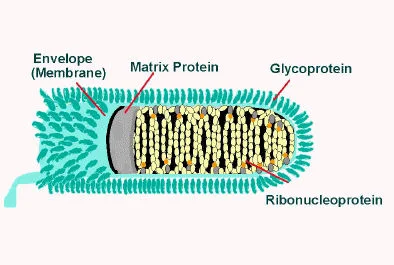INTRODUCTION: No sound invokes more terror in mankind than the bark of a rabid dog. It has terrified man since time immemorial. The fear by no means is unfounded because the disease transmitted by such animal in humans is perhaps the most painful and horrible of all the communicable diseases in which the sick person is tormented with thirst and the fear of water a condition known as hydrophobia, at the same time.
CLASSIFICATION: Rabies virus belongs to the family Rhabdoviridae and genus Lyssavirus which contains four related but distinct virus types.
MORPHOLOGY: The rabies virus is bullet shaped, round at one end and flat at the other. Though the dimensions vary, it ranges between 200 × 80 nm. The membrane at the flattened end of the virion often appears invaginated. Atypical elongated filaments and occasional Vor Y-shaped and conical forms are observed in rabies virus harvested from cell cultures late after infection. Truncated bullets (T-particles) encountered in many rhabdovirus preparations are non-infectious.
CHEMICAL COMPOSITION: The RNA is an unsegmented, single, negative strand which is non-infectious. The RNA is closely associated with a major protein, N and two smaller proteins, L and NS. This structure is tightly coiled and helical in appearance and constitutes the nucleocapsid of the virus. It is enveloped in a lipoprotein membrane through which protrude a large number of spikes with knobs at their distal ends. The inner surface of the envelope is lined by a genome coded M protein. Associated with the envelope is a glycoprotein (G) of which the surface projections are composed.
SUSCEPTIBILITY TO PHYSICAL AND CHEMICAL AGENTS: The rabies virus is highly resistant to cold, dryness, decay, etc. It can remain infectious for weeks in the cadavers. Rabies virus is thermolabile, with a half life of approximately 4 hours at 40°C and 35 seconds at 60°C. However, thermal inactivation is diminished in the presence of serum proteins and chelating agents. The virus remains stable for several days at 0-4°C, indefinitely at –70°C and when freeze dried. This virus cannot withstand pH less than 4 or more than 10. It is also susceptible to the action of oxidising agents, most organic solvents, surface acting agents, quaternary ammonium agents, soaps and detergents. Proteolytic enzymes, ultraviolet rays and X-rays rapidly inactivate rabies virus.
STREET AND FIXED VIRUS STRAINS: The street virus which was first designated by Pasteur as virus des rues refers to the virus isolated from animals and which has not undergone any modification in the laboratory. The strains of this type are characterised by a variable incubation period and by their capacity to invade salivary glands. The fixed virus, by contrast, refers to strains adapted to laboratory animals by serial intracerebral passages which have a short incubation period of only 4-6 days and do not invade the salivary glands. Fixed virus remains neurotropic and its virulence for the central nervous system may get enhanced; it produces paralytic rather than furious symptoms. Its infectivity by peripheral inoculation is diminished, as its ability to induce inclusion bodies in the central nervous system.
PATHOGENESIS: Compared to other mammals man is somewhat less susceptible to the rabies virus. However, the probability of contagion depends on the virulence of the particular virus strain, the quantity of virus transmitted by the bite and location of the bite. Whereas a bite on the face has a contagion index of almost 100% that on the body or leg only about 2%. Once the disease is established there is no cure. After a bite on the human body the neurotropic virus spreads mainly along the endoneural lymphatic ducts, thus reaching the brain and the spinal cord where it multiplies intracytoplasmically in the grey matter. The movement of the virus from peripheral sites to the CNS is effected by passive transport. The rate of movement for some strains has been estimated to be 3 mm/hour. Extensive replication occurs within the brain and terminally neurons in all the parts may be affected.
The symptomatology in cases with rabies is dependent upon the parts of brain affected. Pronounced localisation of virus in limbic system is responsible for furious and aggressive behaviour. Man to man transmission of rabies does not take place but corneal transplants from donors with undiagnosed rabies provide bizarre examples of human to human transmission.
CLINICAL FEATURES: The average incubation period is 30-90 days. It is shorter in case the bite is closer to brain. In a typical course of the disease, the uncharacteristic prodromal stage is followed by the excitation stage with high motor activity, tremors, tonic clonic spasms, opisthotonus, increased salivation, shortness of breath among others. The sight of water, sudden exposure to bright light or loud noise or subjecting him to a current of fast air, trigger violent spasms of the gullet making it impossible for the patient to drink water and hence the name hydrophobia. Unless prolonged by intensive care, disease progresses to coma and death ensues within 3-7 days after its onset. Aggression, delirium and intolerance to stimuli are among the behavioural changes frequently seen in patients with rabies. Hydrophobia does not manifest in all the cases but if present, leaves no doubt about the diagnosis. Death in rabies is usually due to respiratory paralysis while the patient is fully conscious.
RELATED;
1. MUMPS VIRUS
2. EBOLA VIRUS
3. MICROBIOLOGY












No comments:
Post a Comment